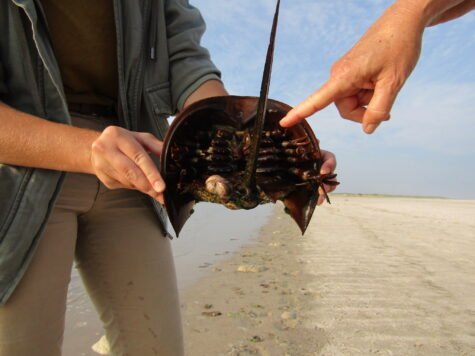
The underside of a horseshoe crab.
By Nicole Cardone
Today I learned many things about horseshoe crabs. Did you know that the females are larger than the males? By about 30 percent! Female horseshoe crabs don’t technically mate. Instead, their eggs get fertilized by a process called spawning. During this process, the female will climb up to the water’s edge, here in the Great South Bay, bury herself in the sand there and release her eggs into the water – thousands of them. At this point, male horseshoe crabs will try their chance at fertilization by releasing their sperm into the water. The lucky ones will land on the eggs.
This process takes place in May and June, more specifically when the full moon occurs, sometimes during the new moon as well. I was lucky enough to see first-hand the cool phenomenon as the sun was going down on the June beach at Smith’s Point breach, created by Superstorm Sandy in 2012.
Accompanied by Park Guide Pat Ryley and Park Ranger Savannah Cabrera, we three ladies took a 4-mile hike along the beach, much being through soft, deep sand, just to see these creatures doing their seasonal reproductive thing. It was definitely worth the walk.
Along the way we saw many other specimens, such as piping plovers, which are endangered and protected; swans, which are aggressive; and even a ghost crab, which got its name because it comes out at nighttime and is unusual to spot. I was lucky to see one!
To be honest, horseshoe crabs freak me out, especially when you see the underside of them. Although completely harmless, their claws and long, spiky tails are intimidating. If you ever find a horseshoe crab flipped on its back helpless and you want to help it, do not pick it up by its tail. Instead, carefully pick them up by the sides, flip them over and return them to their proper position in the water. They will thank you.
Horseshoe crabs are an ancient species. They have existed in the same form for more than 450 million years. This means that they didn’t necessarily need to evolve (at least not drastically) because the way they are now, is the way they were. They managed to out survive dinosaurs. That’s pretty impressive. Their hard shells keep the more delicate parts of their bodies protected from predators, including their 10 eyes. Unfortunately, however, horseshoe crabs are close to endangerment, so it is imperative to protect their habitats.
Another really cool thing that I learned about horseshoe crabs is that their blood is used in vaccination purification testing. Horseshoe crabs have blue blood because it’s copper-based. This blood is able to identify bacterial toxins. When added to a vaccination, this helps tell scientists whether bacteria are present or if the vaccine is pure!
Horseshoe crabs live to be about 20 years old. They molt their skin many times over and over again until they reach maturity at around 10 years old.
Ironically, horseshoe crabs aren’t really crabs at all. In fact, their closest living relatives are scorpions and spiders … maybe that’s why they creep me out.
“Fire Island National Seashore provides a variety of opportunities to explore and enjoy an Atlantic Coast barrier island ecosystem and its history,” says the National Park Service on their website. Programs are educational, interactional, and best of all, they are mostly free to attend. Donations are encouraged. This is great for young people, as they are the future stewards of the Earth and protectors of animals and their natural habitats.































